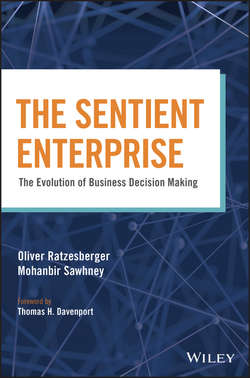Читать книгу The Sentient Enterprise - Ratzesberger Oliver - Страница 6
Introduction
COLLABORATION WITHOUT CHAOS
ОглавлениеEspecially when working with many experts and massive infrastructure that might scale all the way to the global production level, it’s easy for collaboration to veer into chaos if you don’t have the proper platforms and hassle-free governance to help people stay in their lanes. But it’s important for people to still collaborate effectively with those in other parts of the business, so silos don’t develop as barriers to agility.
We’ll see in the chapters to come how that one word —agility– is key to getting the enterprise to the sentient point where it can analyze data and make autonomous decisions at massive scale in real time. Agile systems and processes enable this by loosening IT roadblocks, democratizing data access, breaking down silos, and avoiding costly inefficiencies like data duplication, error, and just plain chaos.
Merriam-Webster’s Collegiate Dictionary defines agile as “marked by ready ability to move with quick easy grace” or “having a quick resourceful and adaptable character.” In the corporate world, business agility is usually defined as a company’s ability to rapidly respond and adjust to change or adapt to meet customer demands. For our purposes, however, let’s entertain a more targeted definition:
Agility is the ability to decompose or break big problems and systems into smaller ones, so they’re easier to solve and collaborate around.
In our effort to build this new agile environment for analytics, we looked across many industries for other examples of agility. This cross-industry perspective can solve problems in one sector by looking to other kinds of business settings for challenges met and lessons learned. The context may be different, but the insights and solutions can be strikingly similar.
For instance, we can learn much about an agile decomposition approach to tomorrow’s data architectures by examining the Open Systems Interconnection (OSI) model that the telecommunications industry deployed as far back as the 1970s. OSI was developed to segment complicated infrastructure (wiring, relay circuits, software, etc.) into manageable chunks for better collaboration among various specialists.
By designing modular but interoperable parts of the system known as abstraction layers, OSI ensured that the work of software programmers, for instance, didn’t conflict with what engineers and line workers might be doing in the field – or vice versa. We like the OSI example because, even though it was developed four decades ago, the technique of segmenting big systems into overlapping but distinct and manageable elements is a powerful ingredient for agility – one that we continue to see in some cutting-edge settings today.
Check out a technology called Docker (https://www.docker.com/) to see what we mean. Docker lets you break down the app-building process into a series of manageable steps. Through a simple Docker Engine and cloud-based Docker Hub, the company lets you assemble apps from modular components in a way that can reduce delays and friction between development, quality assurance (QA), and production environments. By breaking things down into smaller components, Docker aims to make the app-building process more manageable and reliable.
Another example is the entire “microservices” approach to building software architectures. Unlike traditional service-oriented architectures (SOAs) that integrate various business applications together, microservices architectures involve complex applications built from small, independent processes. These processes communicate with each other freely using application programming interfaces (APIs) that are language agnostic.
With microservices, you’re still building powerful architectures; but it happens more efficiently, with modular elements broken down to focus on discrete small tasks. As a result, microservices architectures can be tremendously agile. They facilitate continuous-delivery software development and let you easily update or improve services organized around distinct capabilities such as user interfacing, logistics, billing, and other tasks.
